|
The
Blackhawk Mysteries
Will
Eisner, Chuck Cuidera, and Reed Crandall
Chuck Cuidera
rolled down the aisle in Artists Alley on the first day of the 2001 San Diego
Comic Convention. He had attended his first Con just two years before. Then, he
had been walking; now, he was in a wheelchair, having lost a foot to one of the
maladies that afflict the older organisms. And Chuck was one of them: he was
86, and, just a month later, he would die. But now, on Thursday morning, July
19, he was looking forward to seeing and being seen by Golden Age fans whose
existence he had only recently discovered.
In
this milieu, he found at long last the respect, even veneration—a regard almost
reverential—that his work as a young man should have earned him sixty years ago
but didn’t because then comic books were seen as cheap, gaudy juvenile junk
entertainment whose artisans were, mostly, anonymous. Now in his ninth decade,
he had learned, much to his astonishment, that the artistic endeavors of his
generation of comic book cartoonists were enthused over by rhapsodic devotees
whose number, while not legion, was considerable and whose passion was
unmistakable. That Chuck enjoyed the attention is evident in his having made
the journey all the way across the country from his home in Florida, an arduous
journey for anyone his age but triply so if encumbered by a wheelchair. That he
deserved the attention is beyond dispute.
As
he rolled by the table where I was setting up, I greeted him.
“I’m
Chuck Cuidera,” he responded. “I did the Blackhawks.”
“Yes,”
I said. “I know.”
He
was pleased that I knew. My knowing established his identity with me, and,
since he didn’t have to perform the tedious ritual of credentialling his
bonafides, he could plunge ahead into conversation about the only thing that,
he figured, would be of interest to someone at the Sandy Eggo Con. Blackhawk. 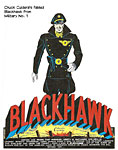 We talked
a little about Everett A “Busy” Arnold, the publisher whose Quality Comics
fostered such memorable characters as Plastic Man, Uncle Sam, The Ray, and The
Spirit as well as Blackhawk. Did he know Arnold? We talked
a little about Everett A “Busy” Arnold, the publisher whose Quality Comics
fostered such memorable characters as Plastic Man, Uncle Sam, The Ray, and The
Spirit as well as Blackhawk. Did he know Arnold?
“I
was his art director,” Chuck said proudly with the air of a man making a
revelation.
But
that had been after World War II. Cuidera had gone into the Army Air Corps in
1942, after producing only the first eleven adventures of Blackhawk and his
airborne minions, the Blackhawks, for Arnold’s Military Comics,
beginning in August 1941. And when he returned to Quality Comics after the War,
another artist, Reed Crandall, had become so closely identified with the
Blackhawks that Cuidera was assigned to a different character, Captain Triumph.
He
continued to work for Arnold, sometimes on Blackhawk stories and, for a time,
as art director, until DC bought the Quality titles in 1956; thereafter,
Cuidera worked for DC, inking Dick Dillon’s pencils on Blackhawk and doing
other art chores. In 1970, he left comics and became a city planner for Newark,
New Jersey. When he retired, he and his wife went to Florida.
I
had steered our conversation to Arnold rather than to the more obvious
conversational destination of the Blackhawks because I didn’t want to get into
the touchy area of who had created Blackhawk. Will Eisner, who was “Busy”
Arnold’s partner in those years of yore, is usually credited with inventing the
character, but when Cuidera surfaced a few years ago in an interview in Comic Book Marketplace (No. 68, May 1999), he had rather loudly denied
Eisner’s role, saying that he and Bob Powell, another artist in the Eisner
shop, had conjured up the quasi-military troupe while Eisner was off hunting
somewhere in the South.
“I
created Blackhawk,” Cuidera said. “Bob Powell helped me write the first story.
As a matter of fact, he did most of it. I had completed [the artwork of] the
whole first Blackhawk story when [Eisner] got back [from his hunting trip]. I
didn’t have every character then, but I had the story done.”
When
it was announced that Cuidera would be a guest at the Comic Con that summer,
just a few months after his revelation in Comic Book Marketplace, and
that he and Eisner would appear together in one of the Golden Age panels
moderated by Mark Evanier, speculation ran rampant about what, given Cuidera’s
unequivocal assertion and even somewhat belligerent stance (“Will Eisner and I
didn’t get along”), promised to be a colorful showdown between the disputants.
Evanier, however, was not about to stage manage a fight, and, if I recall
aright, he arranged a private confabulation between Cuidera and Eisner before
the panel assembled, and during that meeting, whatever strife existed was
smoothed over to each party’s satisfaction.
During the
panel presentation, Eisner cleared the air with a gentlemanly proclamation:
“I’ve
been wanting to say this for a long time, because I’ve done conventions a lot,
and there’s been a lot of talk about who invented what. It’s not important who
created it. It’s the guy who kept it going and made something out of it that’s
more important. Whether or not Chuck Cuidera created or thought of Blackhawk to
begin with is unimportant. The fact that Chuck Cuidera made Blackhawk what it
was is the important thing, and, therefore, he should get the credit.”
Eisner
was being both generous and canny. And accurate. Surely it is true that whoever
puts flesh on the bare bones of a embryonic concept should have the greater
share of the credit for creating the feature. While acknowledging that Cuidera
played the most significant part in perpetrating the Blackhawk mythos, Eisner
didn’t disown the creator’s role. He shifted the credit, but, by implication,
he retained his role as the inventor of the character. But later in the panel’s
discourse, the issue was clouded anew.
In
discussing the first Blackhawk story, Eisner remembered that it was a feature
called “The Death Patrol” that led to the creation of the Blackhawk team.
According to this recollection, Arnold, who apparently kept a close eye on what
transpired in the titles he was publishing, saw “The Death Patrol” and said he
wanted another feature like it.
“The
Death Patrol” was produced by Jack Cole, who joined the Arnold enterprise in
the late fall of 1940. He had been doing an imitation Spirit in Arnold’s Smash
Comics since the January 1941 issue (No. 18), and about the same time that
he produced the first Death Patrol story that spring, he also did the first
Plastic Man tale for the inaugural issue of Police Comics (cover-dated
August 1941). The Death Patrol, dubbed in the first story “a Foreign Legion of
the air,” was made up of a group of escaped convicts, all pilots, led by a
playboy aviator named Del Van Dyne. Eager to do something worthwhile in these
months before the U.S. entry into the War, they all go to England and join the
RAF effort as a sort of free-wheeling squadron against Hitler’s Luftwaffe.
Drawn in Cole’s customarily exuberant style, the first Death Patrol story is
packed with headlong action and odd-angle shots.
The
members of the Patrol are picturesque characters whose eccentricities make them
comedic: Slick Ward, an ex conman; Peewee the forger, whose giant physique
mocks his name; Hank the cowboy, former rustler; Butch O’Keefe, safe cracker
from Brooklyn; and an old timer named Gramps, who earned his way as a
pickpocket. This crew, animated by Cole’s exaggerated action style, gave a
humorous aura to the stories (more so here than in Cole’s other two Quality
efforts at the time), but every Death Patrol tale ended on a somber note: in
each adventure, one of the group dies in battle. With every issue of Military
Comics, a new recruit joins the Death Patrol and another member dies.
When,
at that 1999 panel discussion, Eisner allowed as how the Death Patrol had
inspired the Blackhawks, there was a tremor of puzzlement through the audience,
me included. Since the first Death Patrol story and the first Blackhawk story
appeared in the same August 1941 issue of Military Comics (No. 1), how
could one have inspired the other? Speculation at the time was that the
inspiration came to Arnold as he looked at the artwork for the first Death
Patrol before it was published. And that, doubtless, is what happened.
But
wouldn’t the first Blackhawk story have been in its final state just then
too—well along in the production cycle, rolling, deadline driven, at July
publication? And if so, how could the Death Patrol exert any influence?
Puzzling, but after DC published the first volume of the Blackhawk Archives,
we had a clearer view of the Blackhawk landscape.
With
the first 17 of the Blackhawk stories before us in the Archives,
particularly the first two tales, it seems entirely possible that the notion of
the Blackhawks as a merry band of aviating derring-doers was not part of the
original Blackhawk concept. We have for so long held in fond memory’s embrace
the images of these tumbling fist-fighting combatants, punching their way
across war-torn Europe and wise-cracking as they go, that we are unlikely to
think of Blackhawk without also thinking of his teammates. But little in the
first Blackhawk story in Military Comics No.1 overtly indicates that
Blackhawk will lead a footloose band of fighter pilots in future exploits. A
squadron perhaps, but not a team of idiosyncratic individuals, one from each of
the countries invaded by Hitler. The first Blackhawk story is an almost
straight-forward rehearsal of the title character’s origin without much
reference to any of his team.
The splash
page caption under a picture of Blackhawk striding toward us sets the scene:
“History has proven that whenever liberty is smothered and men lie crushed
beneath oppression, there always rises a man to defend the helpless, liberate
the enslaved and crush the tyrant. Such a man is Blackhawk—out of the ruins of
Europe and out of the hopeless mass of defeated people he comes, smashing the
evil before him.”
A
“man” not a “team.” And the story then reveals how a brave Polish pilot swore
to avenge the deaths of his brother and sister by destroying their killer, a
German flying ace named Von Tepp, and how he did exactly that. Virtually by
himself, without the aid of any teammates. The conclusion of the story promises
future adventures as “Blackhawk turns once again to the task destiny has
allotted him.”
The
story is not entirely without reference to a larger freelance military
enterprise. A caption mid-way through the story re-introduces the Polish flyer
who has now become Blackhawk and refers to “his men” who “swoop down out of
nowhere, their guns belching death and on their lips the dreaded song of the
Blackhawks.”
Seemingly,
a pretty detailed glimpse of the outfit we remember. But the team members are
not introduced in any formal way. They may exist, but they don’t exist as
individuals; they exist as a unit.
And,
more significantly, the caption itself, stretching across the width of the
page, takes an irregular shape to accommodate, I suspect, a late addition of
text—namely, the portion of the caption that I’ve just quoted, the part about
Blackhawk’s men and their battle hymn. My guess is that this part of the
caption was added after the artwork for the story had been completed—after
Arnold had seen the Death Patrol story and issued his demand for another
feature like it.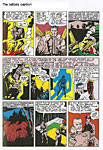
Until
then, I suspect Blackhawk was envisioned as a lone wolf, a knight errant of the
air, acting more-or-less single-handedly to right Nazi wrongs. Once the idea of
the Blackhawk team surfaced, the origin story was tinkered with to foreshadow
their introduction in the second issue of Military Comics. That
formality had to wait until then because the introductory tale of Blackhawk’s
origin had already been completed, and the artwork for the first issue of the
comic book was teetering on the doorstep, on the way out to the printer. There
wasn’t time, just then, to do anything drastic to incorporate Arnold’s dictum.
In
that first story, Blackhawk returns to an island stronghold, but this aspect of
the character’s legend could have existed quite independent of the team idea.
An aerial view of the island locates barracks, indicating that the island
(called “Blackhawk’s Island,” using a singular possessive, not “Blackhawk
Island” as it will be known later) is home base for more than a single fighter
pilot. But an airborne militia need not be a team of individual personalities,
which is what, eventually, distinguished the Blackhawk mythos.
We
hear a chorus of the Blackhawk song and we see Blackhawk’s squadron in action
in the first story, but the action is fairly passive. A couple of them have
been captured by Von Tepp, who lines them up before a firing squad. And then
Blackhawk shows up to rescue them—assisted by his black-uniformed cohorts, who
perch on the walls of Von Tepp’s mountaintop stronghold, surrounding the
hapless Nazi, “like blackbirds of prey.” A neat turn of phrase. But none of the
squadron does anything in particular. All the action is left to their leader.
Blackhawk
takes Von Tepp prisoner and returns to his island. There, he challenges the
German to a duel in the sky and eventually, in a three-page climactic battle,
defeats his nemesis. In short, the emphasis of the story is on Blackhawk, the
solo soldier of wartime fortune.
It
is entirely possible that the first Blackhawk story was written with the
Blackhawk team firmly in mind but only hinted at, as we’ve seen, in the final
product. But if that were the case, I’d expect to find, as we usually do in
similar cases throughout comics history, a more expansive reference to the team
in the inaugural tale.
Nope;
I believe instead that, as Eisner said during that memorable discussion in San
Diego, the team concept was added to the Blackhawk concept after Arnold saw the Death Patrol artwork. By that time, though, the Blackhawk story
was probably in final, inked and lettered, form, so the concept of a team of
individual pilots, like the Death Patrol gang, had to be suggested rather than
delineated. The suggestions were achieved by insinuating into the completed
artwork a couple of caption extensions and, perhaps, a replacement panel or two
(to introduce the Blackhawk song, say). But the basic story remained pretty
much the same, an origin tale about an aviating Lone Ranger. The elaboration of
the team idea was left to the next issue of the book.
In
the second issue of Military Comics, we meet the Blackhawk team members
on their island. That much of the concept had been conjured up before the first
story went to press, and the caption I mentioned had been added to pave the way
to the future.
The
team members we meet include only three familiar names—Andre the Frenchman,
Stanislaus the Pole, and Olaf the lantern-jawed giant Swede. Others who are
named—Boris, Seg, and Hendrick—soon fade from the scene. And Hendrick becomes
Hendrickson (and sometimes Henderson). We don’t meet the Chinese comic relief
character, Chop-Chop, until the third story.
Chop-Chop,
like Olaf, was inspired, Cuidera said, by Milton Caniff’s characters in Terry and the Pirates, the voluble cook Connie and the mute Big Stoop.
“Everyone stole from Milton Caniff back then,” Cuidera said. Chuck, the
American representative, doesn’t show up until No. 11. Since this is Cuidera’s
last pre-war story, I’d say the Blackhawk Chuck was introduced so that the
artist Chuck would remain with his creation by proxy even while away in the
Army.
Stanislaus
was reportedly named after Powell, whose given names were Stanley (for
Stanislaus) Robert. Of Polish descent himself, Powell also lent his national
origin to the title character. Later, this aspect of the character was blurred
and forgotten, and Blackhawk became an American.
Quite
apart from the history lesson afforded by Blackhawk Archives, Vol. 1, we
find a generous dose of Reed Crandall as he crested in artistic virtuosity.
In
Volume 2 of his History of Comics, Jim Steranko says without
qualification that “Crandall unquestionably was the finest artistic talent to
emerge from the world of comic illustration in the forties.” Certainly Crandall
ranks with Lou Fine and Creig Flessell as one of the best, all-around artists
of the period. And Crandall worked in comics longer than Fine and more steadily
than Flessell and supplied, thereby, a more accessible model for other artists
to study and imitate. (If they could.)
These
days, we veer off into rhapsodies about Crandall’s work for EC Comics in the
1950s and for Warren in the 1960s. And in these efforts, Crandall was
undeniably masterful. But his line had become brittle, his pictures heaped with
hay (cross-hatching and shading), his figures, comparatively speaking, stiff.
In his earliest Blackhawk work, his line was confident, more fluid and
flexible, his pictures uncluttered, and his figures were supple and sinewy. The
difference is readily apparent in Steranko’s book, which includes the Blackhawk
band as Crandall rendered them in their classic on-rushing configuration on the
cover of Military Comics No. 13 (reportedly Crandall’s first cover) as
well as another
cluster of the gang, standing woodenly, drawn in 1972 expressly for Steranko.
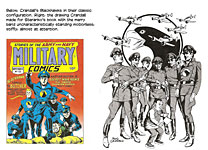
Said
Steranko: “Where Cuidera made Blackhawk a best-seller, Crandall turned it into
a classic, a work of major importance and lasting value.”
Cuidera,
while competent enough with anatomy and facial expression, was better on
equipment and backgrounds. Crandall, however, had mastered the medium in all
its nuances—anatomy, faces, equipage, locales, composition of panels and page
layouts. Cuidera was better than any average you might summon up; but Crandall
was superior in every department. And in DC’s archival Blackhawk, we can
see the difference. It is sometimes subtle (so expert is Cuidera); but it is
there.
With
No. 12, Crandall’s debut on the title, the linework is stronger and the shadows
more numerous and more deftly placed than in Cuidera’s work. And the women,
which crop up now more often, are stunningly beautiful. (Perhaps, in No. 12, due
to Alex Kotsky, who, according to Ron Goulart, did four of the eleven pages.
But beautiful femme fatales continue to appear on Crandall’s pages in Nos. 13,
14, and 17 herein.) Crandall also varied the camera angle more often than
Cuidera—upshots and downshots—all executed for the sake of sheer visual variety
rather than because a scene demanded a different perspective.
And
the search for pictorial diversity sometimes leads to dramatic emphasis. On
page 219 of the DC tome, for instance, in the first panel, a downshot
dramatically implies the fusillade from the aircraft that kills the villains:
shot from above, the picture shows the airplane overhead by means of a
silhouette in shadow, the gunfire with the sprays of sand kicked up by the
rounds, and the death of the bad guys with their contorted postures. 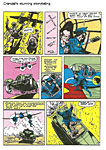
On
the same page, Crandall imparts velocity to a speeding automobile by shooting
up from below and in front, giving to the vehicle the aspect of a soaring
missile. And in the dramatic final panel on the page, he shoots again from
above, from Blackhawk’s perspective, as our hero drops into the fleeing car
from the plane overhead; from that angle, we can see the startled expressions
on the faces of the quarry as they look up to see Blackhawk plummeting towards
them.
But
Crandall’s signal contribution to the Blackhawk books—and the reason he is more
remembered for this title rather than just about any other single series
(except maybe Dollman)—derives from his ability to fill his pictures with
dynamic groupings of figures. Because of his sheer love of drawing and his
surpassing skill at it, he put more of the Blackhawks into more panels than
Cuidera did. Under Crandall’s hand, the stories were clearly, vividly, about a
group of men, a team, that dashed headlong through the panels and across the
pages, legs pistoning, fists swinging—an energetic display of all-out
hand-to-hand action that seemed more sport than deadly combat. And it is for this—for
creating the visual ambiance of a fighting group in action—that Crandall’s work
on the Blackhawks is so memorable.
By
the last issue, No. 17, in the Archives volume, every panel brims with
figures. Crandall almost never draws a picture of a single figure. But he is so
skillful in overlapping one figure with another, in foregrounding one and
backgrounding others, that none of the panels seems crowded. Every figure, it
seems, has plenty of elbow-room—even when the picture is filled with machinery
or background detail as well as personnel.
In
the same issue, we see the classic Blackhawk pose: chest out, arms hanging
loosely at his side, fists clenched, legs spread and knees locked back—a vivid
portrait of power poised like a coiled spring, radiating an athletic pride as
well as potency. It was this characteristic pose that Wally Wood so effectively
caricatured in his Mad take-off on the Blackhawks. It was pure Crandall,
Crandall giving Blackhawk his heroic stance.
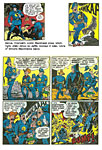 |
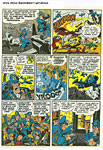 |
By
the time Cuidera returned from military service, the Blackhawks were as much
Crandall’s as his. Crandall had been in the Army Air Corps, too, and, like
Cuidera, he returned to Arnold’s Quality Comics after the war. Crandall did
most of the Blackhawk titles thereafter until Arnold sold his line to DC. By
then, EC was gone, and Crandall was freelancing all around town, at Marvel and
Western. He returned, finally, to his Kansas hometown, where he attended to his
mother until she died and drew classics for Gilberton and other publishers for
a time, submitting his art by mail. His life, and probably his work, what
little he did towards the end, deteriorated, and he died in the fall of 1982
without ever basking in the adoration of his fans at a convention.
Cuidera
did, though. For a couple of years anyhow. People came by Chuck’s spot at the
table just down the row from mine in Artists Alley his last summer. Dave
Siegel, several times. And they smiled and told him they loved his Blackhawk.
His and Reed Crandall’s.
Return to Harv's Hindsights |